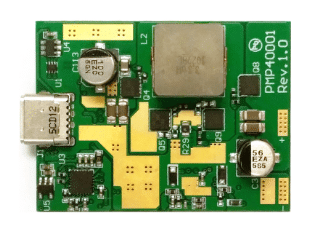This reference design is ideal for various applications, including industrial systems, appliance battery chargers, personal electronics, digital still cameras, and power banks.

The USB Type-C Power Delivery (PD) Downstream Facing Port (DFP) with a cell battery input represents an advancement in power bank technology, offering versatility and efficiency. This configuration allows for high-speed charging of multiple devices, supporting various power profiles and ensuring compatibility across a broad range of gadgets, from smartphones to laptops. With the ability to deliver precise power levels tailored to the device’s needs, it maximizes charging efficiency while minimizing energy loss. The integration of a cell battery input further enhances portability and reliability, making it an essential tool for modern, on-the-go lifestyles. Whether for personal use or in demanding professional environments, this technology underscores the future of mobile power solutions.
The PMP40001 is a reference design by Texas Instruments (TI) for a USB Type-C Power Delivery (PD) Downstream Facing Port (DFP) that is fully equipped to meet modern power management needs. This design leverages a pure analog configuration for the USB Type-C source controller, the TPS25740, simplifying the PD negotiation process. The design supports three distinct output voltage levels: 5V, 12V, and 20V, with a maximum output current of 3A. This allows the design to deliver up to 60W of power at 20V, making it suitable for a wide range of applications requiring different power profiles. It has high efficiency, which can reach up to 96% at full load. This efficiency is achieved through the use of the high-performance LM5175 buck-boost controller, which not only enhances the power efficiency but also ensures good thermal performance, an essential factor in maintaining the reliability and longevity of electronic devices. The design operates within a wide input voltage range of 6V to 13.5V, making it compatible with 2S and 3S lithium battery packs, which are commonly used in portable electronics and industrial applications.
It can support high discharge power up to 20V/3A, fully accommodating the USB Type-C PD profile 4, which is crucial for compatibility with a broad range of devices. Its small size and low component count contribute to its practicality in space-constrained applications, without compromising performance or functionality. The pure analog configuration of the USB Type-C PD negotiation further simplifies the design, reducing complexity and potential points of failure. The design parameters includes three output voltage options (5V, 12V, and 20V) with a consistent maximum input voltage of 13.5V and a minimum input voltage of 6V across all variants. The output current remains steady at 3A for each configuration, resulting in output power capabilities of 15W, 36W, and 60W, respectively. The non-isolated nature of the design, combined with the buck-boost topology, ensures efficient and reliable power conversion suitable for DC input applications.
Texas Instruments (TI)has tested this reference design. It comes with a bill of materials (BOM), schematics, assembly drawing, printed circuit board (PCB) layout, and more. The company’s website has additional data about the reference design. To read more about this reference design, click here.






